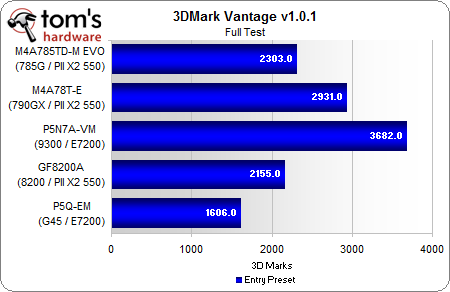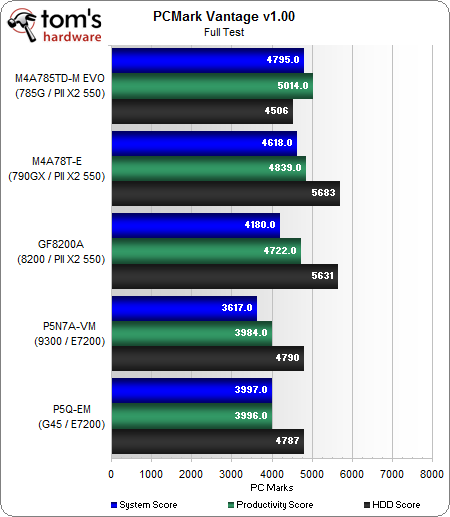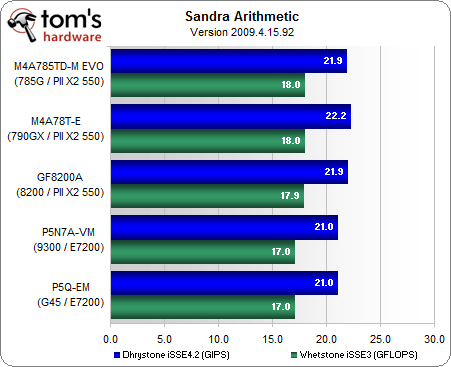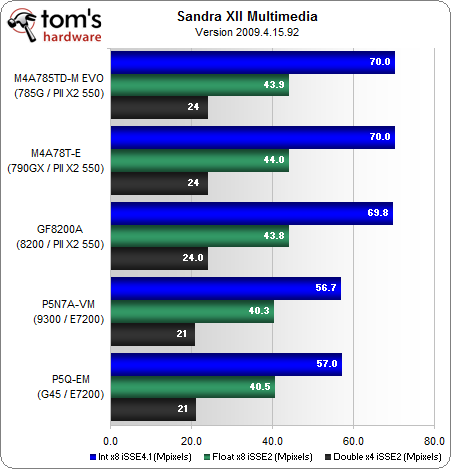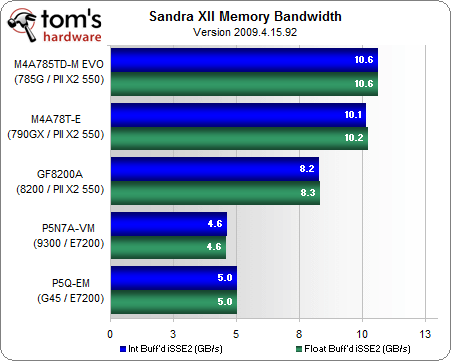Updated: AMD 785G: The Venerable 780G, Evolved
Benchmark Results: Synthetics
Let's begin with the usual suspects, Futuremark's 3DMark and PCMark suites. We should note that they didn't work on the 785G at first, but AMD sent us an updated .dll file that allowed us to run the benches. This is an issue we've seen in the past when the app isn't able to detect the new hardware.
Everything looks about right here, except that the GeForce 9400 is probably a lot higher than it should be compared to the other chipsets, despite the fact that we turned PhysX optimizations off to keep things on an even keel. Unfortunately, 3DMark can create an unrealistic expectation sometimes as we will see in the game benchmarks.
The PCMark results look to be where we would expect them, with the exception of a somewhat slower hard drive result for the 785G. We're looking into that but as of publication time we don't have a explanation. On the positive side, this phenomenon didn't seem to manifest itself in the rest of the benchmarks.
Let's run through SiSoft Sandra's gamut of synthetic benchmarks on all of these platforms, starting with the CPU arithmetic bench:
Not much variance here, but what is incredibly surprising is that these are the results of two different CPUs: the Phenom II X2 550, and the Core 2 Duo E7200. First glance would suggest these competitors are very evenly matched.
We're seeing the CPU's split up a little bit here, with the Phenom II X2 performing notably better when it comes to iSSE4.1
Here's where some real differences come into play. The Phenom II X2 and its integrated memory controller deliver significantly more memory bandwidth. Note that the GeForce 8200 board is running a little slower, as it's the only AMD system using DDR2 memory. Both of the Intel systems, also using DDR2, lose ground.
Get Tom's Hardware's best news and in-depth reviews, straight to your inbox.
Current page: Benchmark Results: Synthetics
Prev Page Test System And Benchmarks Next Page Benchmark Results: Audio And Video EncodingDon Woligroski was a former senior hardware editor for Tom's Hardware. He has covered a wide range of PC hardware topics, including CPUs, GPUs, system building, and emerging technologies.
-
macer1 the real question is how would this perform if mated to an Atom processor in an nettop.Reply -
mcnuggetofdeath "refined architecture" ? To my knowledge, and please correct me if im wrong, all that was changed between the original phenom and the phenom 2 was the addition of more L3 cache allowing it to do more simultaneously and a die shrink allowing for higher clocks. That does not a refined architecture make. When AMD added an on die memory controller to their processors years ago they had made a huge advancement in architecture. Im sad to see them fall away from the performance crown. Here's hoping their new Bull Dozer architecture brings something genuinely intriguing to the table.Reply -
anamaniac Very interesting.Reply
A integrated GPU that can game. =D
Makes my lil Pentium D with a 4670 seem puny...
3.3GB/s memory bandwidth (single channel DDR2 533... though 2 sticks, it runs in single channel... damn prebuilts) also seems sad on my rig...
macer1the real question is how would this perform if mated to an Atom processor in an nettop.
Good question. A dual core Atom with a 4200 integrated would be nice.
We all know Intel makes shitty mothebroards and AMD makes kickass motherboards anyways. -
SpadeM mcnuggetofdeath^^^ and support for DDR3. Although thats a change to the board, not the CPU.Reply
Not correct, the P2 has a built in memory controller so the switch to ddr3 affected that controller -
apache_lives anamaniacVery interesting.A integrated GPU that can game. =DMakes my lil Pentium D with a 4670 seem puny...3.3GB/s memory bandwidth (single channel DDR2 533... though 2 sticks, it runs in single channel... damn prebuilts) also seems sad on my rig...Good question. A dual core Atom with a 4200 integrated would be nice.We all know Intel makes shitty mothebroards and AMD makes kickass motherboards anyways.Reply
Native ram for a pentium d is PC4200 which has a max of 4.2gb/s per channel etc and the FSB has the max of 6.4gb/s
The Intel atom would most likely underpower any video card out there, and Intel does actually make a good reliable business platform where video performance is not required etc -
I'm sorry, is this an Intel benchmark site? All other reviews put SYSTEM power consumption for Athlon II 250 well below Intel E7200.Reply
-
aproldcuk This article raised a lot of questions for me. What about Hybrid Crossfire for example? What kind of cards can be used together with this new IGP? Is the discrete graphics card on standby if no performance is required? If no then how much extra outlet wattage is expected? And how much extra if actively in use? I'm interested in using the 785G solution in the 24/7 HTPC setup with the possibility to do occasional gaming as well. My current setup with 690G chipset and Athlon 64 X2 BE-2350 CPU draws around 50 watts most of the time and up to 90 watts under heavy load. Is it too much to expect similar levels from 785G and Phenom II X3 705e combo for example?Reply -
wh3resmycar when can we see the mobile version of this? this is most certainly a welcome update compared to the 780g-hd3200 chipset. and beats any nvidia igp hands down. id love to see this on an $700-$800 laptop. good thing im still holding back on buying a new notebook.Reply
